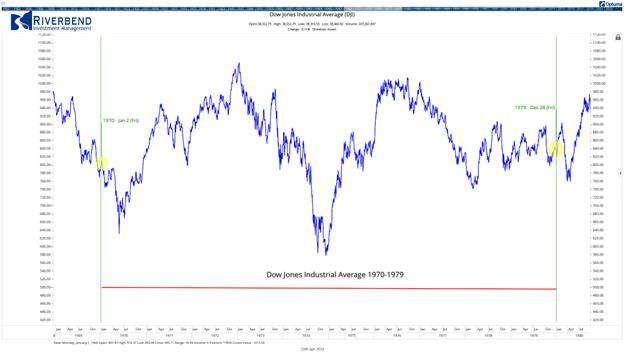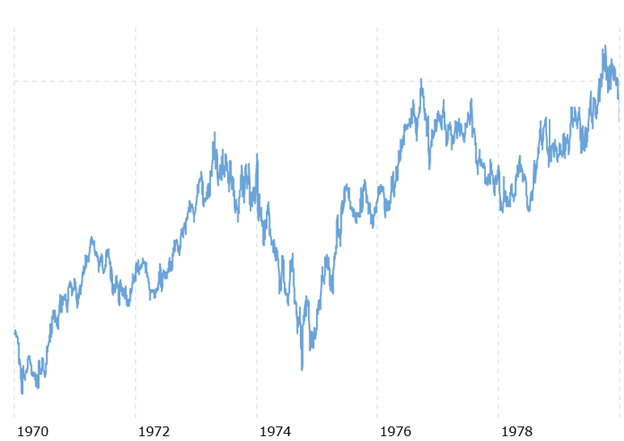Given how loosely all the title terms are used, let’s start with the definitions of each.
1. Disinflation
- Definition: A slowdown in the rate of —prices are still rising, but at a slower pace.
- Impact: Often seen during tightening monetary policy, it’s not negative like deflation and can indicate successful inflation control.
2. Stagflation
- Definition: A period of high inflation combined with stagnant economic growth and high .
- Impact: Particularly difficult to manage because the tools to fight inflation (like raising rates) can worsen unemployment and vice versa.
And here are examples of each “flation” condition
Disinflation or slowing inflation (prices rise but more slowly), and the best example is the 1980s under Volcker
Stagflation or stagnant growth and higher inflation, and the best example, is the U.S. oil shock of the 1970s.
Where are we now in the US?
Comparison With Other Categories

One caveat on what seemingly is our current stagflation environment is the impact of AI, especially in tech and certain white-collar roles.
For example, Amazon (NASDAQ:) & Microsoft (NASDAQ:): Both have announced mass layoffs in 2025, citing their aggressive shift to AI as a primary driver. Amazon CEO Andy Jassy explicitly stated that AI will “eventually replace” some corporate roles, prompting layoffs and hiring freezes.
The Long-Term Transition: Adoption of AI doesn’t eliminate all jobs—some jobs are redefined, new ones created—and rehiring can follow initial cuts.
So, let’s go with stagflation (with the caveat) and offer you actionable investment plans.

The top chart of the shows the trading range DJIA remained in until 1982 post Volcker squashing inflation, followed by the brief recession, and then the ensuing economic growth.
This chart here is of in the 1970s. It did not go straight up. Rather, after the Yom Kippur war, oil dropped and then started in the mid-decade, to rise again. 
From I wrote about the long bonds and what happens if we do not have an oil shock like the one you see we had in the 1970s.
But what if we do?
The FED is a big player here on what happens next.
Will the ? Stay the course? Raise? Doubtful they raise. Maybe they will cut. But if they stay the course, will an oil shock impact monetary policy much?
So far, we are witnessing the potential for higher oil and lower yields, but we shall see.
Meanwhile, back to the 1970s.
was the single best-performing asset class of the 1970s.
and other precious metals also posted huge returns as investors sought inflation hedges.
Defensive sectors like , , and outperformed as investors favored companies with pricing power that could maintain profit margins even with high inflation.
stocks, as economically sensitive areas like autos and housing were hit by the combination of high inflation and slow growth.
and growth stocks broadly underperformed as soaring inflation and interest rates compressed their rich valuations.
However, currently, we are seeing tech and growth well outperforming, so unless we see a rate hike or inflation growing substantially, these sectors might hold in a range until valuations become too rich.
In 2025, while we can still make a case for disinflation (good for growth), we must carefully watch the similarities to the 1970s.
If this is disinflation, then the prices falling but still high can indicate successful inflation control.
And that’s the rub.
The market is dancing between disinflation and stagflation.
Hence, we will continue to watch:
- Oil
- Gold to Silver Ratio
- Sugar prices
- Tech stocks (NVDA)
- Dollar
- Long bonds
ETF Summary
(Pivotal means short-term bullish above that level and bearish below)
S&P 500 (SPY) 600 support
Russell 2000 (IWM) 215 resistance 205 support
Dow (DIA) 425 near support
Nasdaq (QQQ) While making a new all-time high, 540 now has to hold
Regional banks (KRE) 55 support 60 resistance
Semiconductors (SMH) 283 2024 high and now 270 key support
Transportation (IYT) 68 resistance 66 support
Biotechnology (IBB) 123 support 130 resistance
Retail (XRT) 75.50 support 77 now pivotal resistance
Bitcoin (BTCUSD) 105k support 110 resistance

